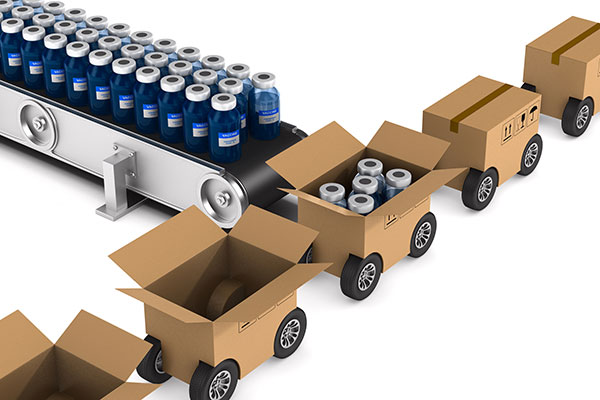If Meri Stevens hadn’t become a supply chain executive – she’s currently the Worldwide Vice President Consumer Health Supply Chain and Deliver at Johnson & Johnson – she might have had a career as a cardiologist.

In a recent conversation we had about J&J’s supply chain the phrase flow blockers came up several times. It makes sense if you think about how blood flows through the body and how goods should flow through the supply chain: Both sometimes need intervention to keep things flowing properly. “I think of the flow as a digital thread that starts with the consumer and then goes all the way back to the ground through our partners to our suppliers,” she said. “We look for the flow blockers in that thread and ask how we can use automation and digital technologies to eliminate them.”
Digital transformation is an area garnering a significant percentage of supply chain investment at J&J, a perennial leader on Gartner’s list of the Top 25 supply chains, including Number 4 in 2022. But digital transformation was only one of the topics we touched on. They also included reliability and resilience, the importance of having a seat at the C-suite table and winning the war on talent.
A career in supply chain
Stevens is an engineer and supply chain veteran with over 30 years of experience in the industry. She began her career in operations management at GE, where she spent more than a decade. Before joining J&J in 2015 as the VP of supply chain strategy and deployment, there were stints at companies as diverse as Bertelsmann, Tyco and Newell Rubbermaid, where she was the chief supply chain officer for two years. “I think I’ve been in every industry but food,” she said, adding that J&J marks her third tour in the healthcare industry. “If you think about leaving a lasting impact, healthcare is a key area where you really want to drive something different.”
She has that opportunity at J&J, where her portfolio includes every process in the SCOR model, from planning to sourcing direct materials through the make, deliver and return functions. She is responsible for delivery of the J&J products that touch our everyday lives, such as BAND-AID® Brand Adhesive Bandages, suntan lotion, allergy medications, TYLENOL®, LISTERINE® and shampoo, to name a few. Her team was responsible for the cold chain that delivered J&J’s COVID vaccine, and she has been involved in revamping the medical device organization from a delivery perspective.
Reliability and resilience
The consumer health supply chain is massive. Stevens oversees operations that serve over 1 billion people every day in 60 countries. What drives that supply chain? First and foremost, its “choices around reliability and resilience,” Stevens said. “When you’re serving more than a billion people a day, the most important thing is to make sure that when you reach for our product on the shelf that it’s going to be there for you.” That was never more important than before the development of COVID vaccinces and anti-virals, when consumers around the world reached for TYLENOL® for some relief from their symptoms. Demand for an otherwise stable product soared.
That focus on reliability influences decisions about how J&J balances what it manufactures in its own facilities versus manufacturing partners – what Stevens described as “manufacturing in a way that creates agility;” whether product is stored in J&J distribution centers or with 3PLs: and, increasingly, how and where the company sources its materials and develops new suppliers. “One of the things we are working on extensively is understanding our dual sourcing strategy,” Stevens said. “And, because our portfolio in many cases came together through acquisition that can sometimes take us longer.”
“Our two axes are where is the consumption happening and where is the best source of supply,” she said. “With those, we look at the partnerships we’ve developed. In a perfect world, I would have everything nearby, infinite capacity and 100% agility. But, in an imperfect world, I’m constrained by where I am today and the changes that I can make now. So, it’s about balancing those things as we go.”
Responding to volatility
Like most organizations, J&J’s supply chain was tested during the pandemic. “The biggest thing we experienced was volatility, especially in the consumer business,” Stevens said. “We saw quite a variation in where people are buying product and what they’re buying.” The demand for some traditionally stable products doubled and tripled.
As a result, J&J is investing heavily in digital capabilities to better sense and understand demand. “There has been an explosion in this area that allows companies to combine different kinds of data,” Stevens said. Those include the structured data that companies have always relied on, such as historical sales and channel data for specific products. But also unstructured data. As an example, J&J is incorporating weather data to better understand how consumers are buying sunscreens and allergy medications.
“People are buying products like ZYRTEC® that were once seasonal almost all year long,” Stevens says. “So, now we’re using digital tools in order to predict demand all the way to the shelf level.” That’s demand at a macro level. But J&J is also focused on understanding how demand in a place like Peoria might differ from New York City, as well as whether consumers in those localities are buying at the local store or online. “We want to understand the total global demand for a product so that we can make sure we have inventory available where and when it’s needed,” Stevens said. “That’s why these investments in digital capability are critical to managing capacity.”
She added: “We’re investing for the long term because we think certain trends have changed permanently.”
Pulling on the digital thread
J&J’s digital investments are aimed at transforming supply chain from a constraint to a competitive advantage. The digital thread Stevens referred to earlier is that abilitity to get every piece of information about every step in the process. “I want to be able to spot trends so I can be adaptive and predictive in order to drive responsiveness,” Stevens said. “With that wealth of information, I can look at where I have what we call flow blockers in the thread. Those are the biggest opportunities to use automation, whether it’s digital automation or robots or 3D printing. We ask how we can use those capabilities to eliminate that flow blocker so that I can make the thread work faster.”
In an organization as big as J&J, there are digital initiatives happening in across all processes: Team members go on scouting trips to identify promising new solutions; test them; and if successful, scale them. Stevens identified two projects currently underway. One is a project with a startup and one of the world’s largest retailers to use intelligent digital automation to predict how much product is going to get pulled from the shelf at any retail location. The solution brings together the unstructured data Stevens referred to earlier along with point of sale and inventory level data that J&J already receives from retailers. “We got amazing results during testing, so now we’re scaling that solution globally,” she said. “It will work as easily with our big retail partners as with our small mom and pop shops in India.”
The second project is an optimization engine to better utilize trailers and shipping containers, both of which are severely constrained – clearly flow blockers. “We’re able to take the order information for a load and optimize trailer and container utilization in a way that is really allowing us to get increased capacity.” A side benefit is that better container utilization means fewer trucks on the road, which also results in less carbon emissions. “We benefit from a cost perspective, but also get the benefit of reduced greenhouse gases,” Stevens said.
Given all of the emerging technologies available today, I wondered whether there was one in particular that Stevens was watching. “What we explore is very heavily dependent on what we think is the biggest flow blocker to attack,” she said. “Rather than try to solve all flow blockers at once, we prioritize and focus. That allows us to go quickly.”
Supply chains are still about people
For all the focus on technology, supply chains are still operated by people. And, people are perhaps the biggest constraint – the biggest flow blocker - in today’s supply chains, including J&J. “We’re fighting for people every single day,” Stevens said. Her focus is on building a culture that embraces diversity “where everyone is able to come into the office every single day feeling like they can be their best selves,” she said. “It’s about searching for great talent across different ways of thinking, and then allowing that great talent to feel included.”
Stevens is directly involved in J&J’s WiSTEM2D initiative, or Women in Science, Technology, Engineering, Math, Manufacturing and Design, and is the executive sponsor of the youth pillar. “We feel that women and especially people who are disadvantaged or people of color tend to fall of the stem track at a young age. Once you fall off, you can’t get back on,” she said.
She noted that J&J has events going on around the world almost every day to get women and young girls involved in science and technology. The company also sponsors a program called Johnson & Johnson Re-Ignite, which is aimed at bringing women with science and technology backgrounds who may have left the field to raise children or care for parents back into workforce.
“We want to make sure that we’re opening our doors for every type of talent so that we can be the great company we want to be all the time,” Stevens said.
SC
MR


Latest Supply Chain News
- How CPG brands can deliver on supplier diversity promises
- How S&OP provides the answer to in-demand products
- AI, virtual reality is bringing experiential learning into the modern age
- Humanoid robots’ place in an intralogistics smart robot strategy
- Tips for CIOs to overcome technology talent acquisition troubles
- More News
Latest Podcast

 Explore
Explore
Topics
Latest Supply Chain News
- How CPG brands can deliver on supplier diversity promises
- How S&OP provides the answer to in-demand products
- AI, virtual reality is bringing experiential learning into the modern age
- Humanoid robots’ place in an intralogistics smart robot strategy
- Tips for CIOs to overcome technology talent acquisition troubles
- There is still work to do to achieve supply chain stability
- More latest news
Latest Resources

Subscribe

Supply Chain Management Review delivers the best industry content.

Editors’ Picks




